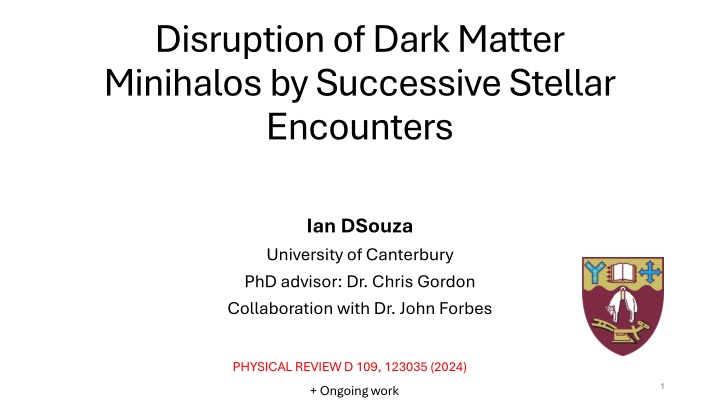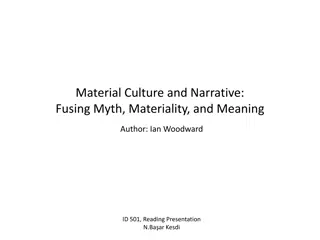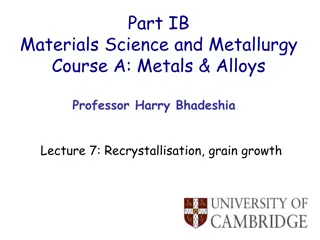
Disruption of Dark Matter Minihalos by Stellar Encounters Research
Explore the disruptive effects of successive stellar encounters on dark matter minihalos, impacting direct dark matter detection possibilities. Join the investigation into axion minihalos and their NFW profile through simulations and analytical models of mass disruption due to stellar interactions. Discover the ongoing work and collaborations shaping the understanding of these minihalos in the study of cold dark matter candidates.
Download Presentation

Please find below an Image/Link to download the presentation.
The content on the website is provided AS IS for your information and personal use only. It may not be sold, licensed, or shared on other websites without obtaining consent from the author. If you encounter any issues during the download, it is possible that the publisher has removed the file from their server.
You are allowed to download the files provided on this website for personal or commercial use, subject to the condition that they are used lawfully. All files are the property of their respective owners.
The content on the website is provided AS IS for your information and personal use only. It may not be sold, licensed, or shared on other websites without obtaining consent from the author.
E N D
Presentation Transcript
Disruption of Dark Matter Minihalos by Successive Stellar Encounters Ian DSouza University of Canterbury PhD advisor: Dr. Chris Gordon Collaboration with Dr. John Forbes PHYSICAL REVIEW D 109, 123035 (2024) 1 + Ongoing work
Axion Minihalo QCD axions solve the Strong CP problem and are a candidate for cold dark matter. During the matter-radiation equality, isocurvature axion density fluctuations decouple from Hubble flow and collapse to form a virialized gravitational structure called the axion minihalo. Primordial axion minihalos undergo hierarchical merging. Axion minihalos can affect the chances for direct dark matter detection. 2
Axion minihalos NFW Profile Simulations show that the minihalos have a spherically symmetric Navarro Frenk White (NFW) density profile: ?(?) = ?? (?/??) 1+?/??2 ?? is the scale density and ?? is the scale radius. Concentration parameter is defined as ? ?vir /?? . 3
Model of mass disruption due to stellar encounters Kavanagh et al. (PRD 104, 063038) (K2021) proposed an analytical model of mass loss using the phase-space distribution of axions in the minihalo. Our improvements: Sequential stripping model: Outer shells are stripped off first before an inner shell is stripped off. This affects the gravitational potential of each axion. After stellar interaction, the remnant minihalo is assumed (based on numerical simulations) to gravitationally relax into a Hernquist density profile: ?(?) = (?/?1) 1 + ?/?1 ?1 3 4
Successive Stellar Encounters Shen et al - APJ 962:9 (25pp) (S2024) 5
Code to Evolve Minihalo Trajectory lbparticles is a Python implementation of an epicyclic orbit solver proposed by Lynden-Bell (2015) for bound orbits in a spherically symmetric potential. Given the initial state (position and velocity) of the minihalo, and a known potential, lbparticles derives a set of coefficients that can be used to evaluate the minihalo s state at an arbitrary time in the future. 6
Energy injection during a disk pass For a single disk pass, the energy injection parameter is (S2024): is the stellar surface density for one disk pass. 7
Energy injection during a disk pass McMillan (2011) MNRAS 414, 2446 2457 - stellar volume density - central surface density - scale height - scale length 8
Effective energy injection St cker et al. proposed a formula for effective energy injection in the multiple disk passes: S2024 assumed p=2. They did not take into account the density profile changes in the minihalo, in between disk passes. Given enough time for relaxation in between disk passes, we found that p~1. Thus, multiple disk passes incur more mass loss (higher Efrac,eff) than simply adding the energy injection parameters. A qualitatively similar result was reported by Delos (2019). 9
Summing energy injection for multiple disk passes Time scale of relaxation (post-encounter) for a minihalo is called the dynamical time: If time between consecutive disk passes < dynamical time, energy injection parameters are added up linearly (p=2): If time between consecutive disk passes > dynamical time, energy injection parameters are added non-linearly (p=1): 10
Mass today after stellar disruption To find the mass contained in minihalos in the Milky Way galaxy: We compute the mass in minihalos both in the presence of stellar disruption (Msurv) and separately without considering stellar disruption (Mori). We compute the percentage of minihalo mass that survives today as: S2024 finds this value ~ 58% Our result ~ 30% 11
Conclusion We improved upon the K2021 analytical model by introducing the sequential stripping method, and minihalo relaxation. We explored successive encounters and found the mass loss is more severe than simply adding up the energy injection parameters, given enough time for minihalo relaxation. We developed a new code to evolve the minihalo orbit. We compared the time between consecutive stellar disk passes to the dynamical time, to more accurately add energy injection parameters. We found that the percentage of minihalo mass that survives today is significantly smaller than that reported in the literature. 12
Mass Function of Minihalos Primordial adiabatic perturbations of axion collapse to form large adiabatic halos which become hosts to galaxies. For a population of minihalos, the mass function tells us the number density of minihalos in a unit mass interval (S2024, Xiao et al - PRD 104, 023515). adiabatic isocurvature 14
m_\kappa is the characteristic mass of the most effective disruptor. It is derived from the present-day stellar mass function. It is unlikely that we would be inside a minihalo. So, lower the value of M_{surv}/M_{ori}(> 1e-12 MSolar), the more likely that dark matter will be detected in direct detection experiments because the mass that has been disrupted ends up becoming part of the background dark matter density. 15


















